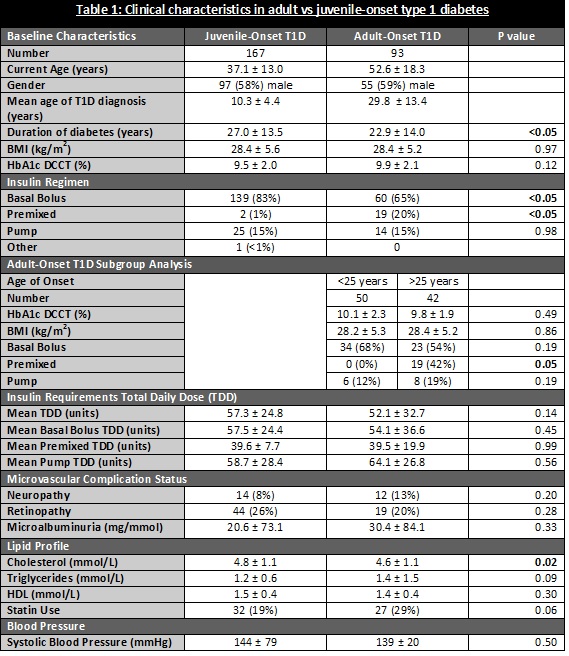Poster Presentation Australian Diabetes Society and the Australian Diabetes Educators Association Annual Scientific Meeting 2016
Clinical characteristics in adult vs juvenile-onset type 1 diabetes (#234)
Introduction
Type 1 diabetes (T1D) characterized by immune mediated destruction of pancreatic beta cells can manifest in childhood or adulthood. It has been postulated that juvenile-onset T1D may be associated with more severe insulin deficiency, different clinical phenotype and treatment compared to adult-onset.1
Objective
Our study aim was to determine if treatment differences exist between juvenile-onset (age <18 years) and adult-onset (age >18 years) of T1D.
Methods
T1D subjects analysed were from the Royal Melbourne Hospital BioGrid Diabetes Database (n=260). Baseline characteristics, body mass index (BMI), lipid and statin usage profiles, microvascular complications, insulin regimens and doses were extracted. Subjects without complete data-set were excluded. Student’s T-test and chi-square were used for statistical analysis with p value <0.05 considered significant.
Results
The mean age at diagnosis was 10.3±4.4 years in juvenile-onset group (n=167) and 29.8±13.4 years in adult-onset group (n=93). The adult-onset group had significantly shorter duration of diabetes (22.9±14.0 years vs 27.0±13.5 years, p<0.05). Total cholesterol was higher in juvenile-onset group 4.8±1.1 mmol/L vs 4.6±1.1 mmol/L (p=0.02) however statin use was comparable (p=0.06). Prevalence of microvascular complications and hypertension were similar. Premixed insulin was used more frequently in adult-onset group 20% vs 1.5% (p<0.05) with no significant impact on HbA1c (9.9±2.1% vs 9.5±2.0%, p=0.12). Subgroup analysis of adult-onset group (median age 25 years, IQR 21–29) demonstrated significantly higher use of premixed insulin in adults diagnosed after the age of 25 (42% vs 0%, p=0.05).
Conclusion
Treatment differences may exist depending on the age of diagnosis of T1D. Our study found higher use of premixed insulin with increasing age of diagnosis. More studies are needed to investigate potential phenotypic differences between adult and juvenile-onset T1D to assist their management.

- Rodacki et al. Characteristics of childhood and adult-onset type 1 diabetes in multi-ethnic population. Diabetes Res Clin Pract 2005;69:22-28.